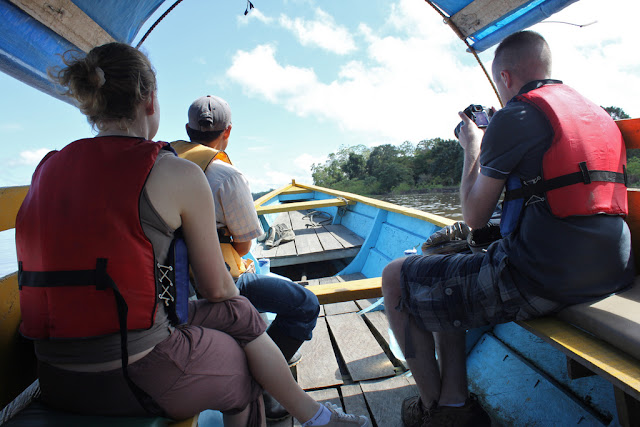 |
| Manaus - Port region |
Manaus is the Amazon’s largest city, an incongruous pocket of urbanity in the middle of the jungle, a major port for ocean vessels that’s 1500km from the ocean. The rain forest has a population density half that of Mongolia’s, but the journey there invariably begins in (or passes through) this bustling city of two million souls. Don’t be surprised if you feel a little out of whack.
The city itself has some genuinely rewarding sights, including a leafy zoo with as many animals out of the cages as in them, and a beach-and-museum combo that gets you out of the city center. It’s a place to stock up on anything you forgot to pack, or to refill your tank with beer and internet after a week in the forest.(visit: lonelyplanet)
Manaus was at the center of the rubber boom of the Amazon region during the late 19th century. For a time, it was "one of the gaudiest cities of the world". One historian has written, "No extravagance, however absurd, deterred" the rubber barons. "If one rubber baron bought a vast yacht, another would install a tame lion in his villa, and a third would water his horse on champagne." The decadence extended to a grand opera house, vast domes and gilded balconies, and marble, glass, and crystal, from around Europe. The opera house cost ten million (public-funded) dollars, but its foolhardiness was demonstrated by the death by yellow fever of half the members of one visiting opera troupe. The opera house, called the Teatro Amazonas, still exists today; it has been restored, was used in the Werner Herzog film Fitzcarraldo, and after a type of interlude lasting almost 90 years, presents operas once again.
Teatro Amazonas: Italian Renaissance Opera House built in the 1890’s with marble and frescoes from Italy, wrought-iron bannisters from England, crystal chandeliers and tiles from France. Closed for many years, the theater reopened in 1997 and now hosts international entertainers.
 |
| Foto by Sergio Correa da Costa via skyscrapercity |
 |
| hosted on flickr |
 |
| hosted on flickr by VitalySky |
When the seeds of the rubber tree were smuggled out of the Amazon region, Brazil lost its monopoly on the product and Manaus fell into poverty. The rubber boom had brought electricity to the city before it arrived in many European cities, but the end of the rubber boom made the generators too expensive to run, and the city lost artificial lighting for years.
 |
| Benjamin Constant bridge (Foto via skyscrapercity) |
 |
| Via Skyscrapercity |
 |
| Bridge at night (Foto riker souza via flickr) |
 |
| Manaus arena (soccer) |
 |
| Boats on the Amazon River |
 |
| Manaus Mall |
For those expecting to see only a sea of green of the Amazon rainforest when they fly into Manaus, the sight of a modern city with high-rises and a busy port comes as a surprise. Located on the north bank of the Rio Negro, 11 miles (18 km) above the Meeting of the Rivers where the Negro merges with the Rio Solimões, Manaus is 900 miles (1,450 km) inland from the Atlantic. It’s the heart of Amazonia and thus the hub of tourism for the rivers, the jungle lodges and the river cruises.
One of the most spectacular tourist attractions in Manaus, the meeting of waters is a must-see on a visit to Amazon. Two rivers that meet and do not mix its waters.
The Meeting of Waters (Portuguese: Encontro das Águas) is the confluence between the Rio Negro, a river with dark (almost black coloured) water, and the sandy-coloured Amazon River or Rio Solimões, as it is known the upper section of the Amazon in Brazil. For 6 km (3.7 mi) the river's waters run side by side without mixing. It is one of the main tourist attractions of Manaus, Brazil. The same also happens near Santarém, Pará with the Amazon and Tapajós rivers.
This phenomenon is due to the differences in temperature, speed and water density of the two rivers. The Rio Negro flows at near 2 km per hour at a temperature of 28°C, while the Rio Solimões flows between 4 to 6 km per hour a temperature of 22°C. wikipedia
There are dozens of travel agencies that offer the tour to the region in itineraries that often include a return by the streams of the region. If the tour is done in a small boat, visitors can put your hand in the water during the crossing from one side to the other of the waters, and feel that the rivers have different temperature. The end of the tour is on a floating restaurant with typical Amazon foods.
As the largest city and a major port on the river, Manaus is commercial. Local industries include brewing, shipbuilding, soap manufacturing, the production of chemicals, the manufacture of electronics equipment, and petroleum refining of oil brought in by barge. And tourism, of course.
Some of the hotels:
 |
| Manaus Forest Hotel |
 |
| Tropical Hotel of Manaus |
 |
| Tropical Hotel of Manaus |
 |
| Ariú Amazon Towers Hotel |
Imagine a hotel built among Amazon treetops: catwalks 70 feet up leading from a great circular dinner room of polished tropical woods, a bar like an eagle's nest, a honeymoon suite built 110 feet up a mahogany tree, and friendly monkeys, macaws, sloths, and parrots scampering, fluttering, and dangling all over the place.
 |
| Forest Hotel |
 |
| Another Forest Hotel around Manaus |
Jungle Tours
The rainforest and the wildlife of Amazonia are the prime attraction of this area. You can spend as little as a day or as much time as you like exploring the backwaters and less inhabited river areas and the igarapés, or tiny jungle streams.



































































